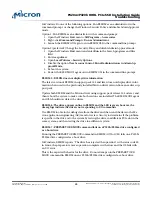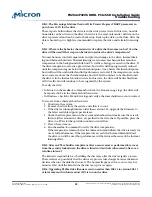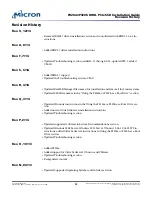
L-12: Can orderly/surprise removal/insertion be performed on an OS-bootable drive?
No, orderly/surprise removal/insertion should not be attempted on an OS-bootable
drive. The file system may become corrupted and the system unresponsive.
L-13: Error message after installing the Micron driver on XenServer 6.2 systems
The following error appears after installing the Micron driver on Xenserver 6.2:
Error:
Module mtip32xx is in use
.
This error occurs when a background process holds the existing driver module.
Run the following command to release the kernel process holding the existing driver
module:
undevtrigger
L-14: Can hdparm be used instead of RealSSD Manager to run a secure erase opera-
tion or read SMART data on the P420m/P320h drive?
The hdparm tool versions 9.15–9.41 has a bug (http://sourceforge.net/p/hdparm/bugs/
49/) in the hdio_taskfile structure that has incompatible bit fields in the Linux kernel.
This prevents the tool from reliably performing a secure erase operation or issuing ATA
commands to the drive.
VMware Driver
VM-1: How do I configure VMware to increase drive performance?
Using paravirtualized network and storage adapters can increase performance by re-
ducing the I/O overhead of the device driver within each virtual machine (VM). VMs
running Windows or Linux have different support requirements for paravirtual control-
lers for boot devices. In general, without including the VMware tools in the boot image
of a VM running Windows, you will not be able to boot from a paravirtual storage con-
troller. For VMs running Linux, it is possible to boot and install the OS on a paravirtual
storage controller without VMware tools.
Note:
Always install the latest VMware tools driver in each VM to take full advantage of
paravirtual hardware.
VM-2: What configurations can increase performance?
In Windows systems, use the PVSCSI storage adapter and set the maximum queue
depth to
255
in the VM's registry settings.
In Linux systems, modify, build, and install a modified version of the PVSCSI driver to
reach 255 queue depth in Linux. (The maximum queue depth of the standard PVSCSI
driver is set to 64. )
Set the kernel parameter
Disk.SchedNumReqOutstanding
to
255
.
ESXi Kernel prior to ESX5.5i:
• In VSphere, click on the
Configuration
tab for the server and select
Software
>
Ad-
vanced Settings.
• Change the
Disk.SchedNumReqOutstanding
from 32 to the maximum queue depth
value (
255
).
• Enable
storage I/O control
on all datastores by opening VSphere and selecting
Stor-
age
>
Datastore
>
Properties
.
P420m/P320h HHHL PCIe SSD Installation Guide
Troubleshooting
PDF: 09005aef8497e00a
P420m_P320h_HHHL_installation_guide.pdf - Rev. V 12/14 EN
39
Micron Technology, Inc. reserves the right to change products or specifications without notice.
©
2012 Micron Technology, Inc. All rights reserved.
















































